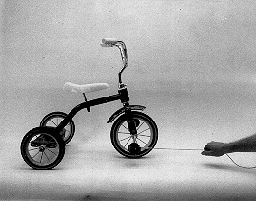

PURPOSE: To illustrate a tricky problem in rotational dynamics.
DESCRIPTION: A tricycle is "fixed" so that the steering wheel is locked in the forward/backward direction. When a rope is attached to the upper pedal (not pictured), held parallel to the floor, and pulled, the tricycle clearly moves in the direction of the pull (the forward direction). Q: How will the tricycle move if the rope is attached to the lower pedal, as shown in the photograph above, and gently pulled? A: The tricycle will move forward, in the direction of the pull. This counterintuitive result can be argued qualitatively by viewing the system in the coordinate system of the wheel. Compare the pull with starting the tricycle by sitting on the seat and pulling the lower pedal backward.
A "pedal extender" (not shown) can be mounted onto the pedal, pointing downward, to perform the following variations of the above experiment. (1) If the rope is attached at a radius less than the radius of the wheel the tricycle will move forward. (2) If the rope is attached at a radius greater than the radius of the wheel, the tricycle will move backward. (3) If the rope is attached at a radius equal to the radius of the wheel, the tricycle will remain fixed in place while the wheel spins.
SUGGESTIONS: Before doing the experiment let your students vote whether the tricicle will move (a) forward, (b) backward, or (c) remain in place while the wheel spins.
REFERENCES: (PIRA 1K10.40) See Demonstration Reference File for articles discussing this experiment. Also see Demonstration D1-83.
EQUIPMENT: Tricycle, as photographed.
SETUP TIME: None.
 |  |
 |  |
 |